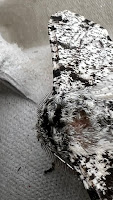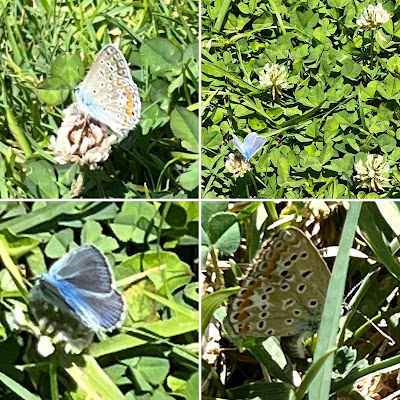Here is your Greek correspondent in action, showing his patient but ultimately unrewarding stalking of the country's many, jewel-like blue butterflies. Unlike my somnolent moths in the light trap of a morning, blue butterflies in the Mediterranean sunshine jink and dart about and seldom rest for long. They are also very wary of intruders so prepare yourself for some abysmal lack of focus.
One which is kinder than most is the Geranium Bronze, a delicate adventist from South Africa which arrived in the Balearic Islands in a shipment of plants in 1987 and has since spread happily - albeit less happily for owners and grows of geraniums and pelargoniums. There were several on the flower-lined steps to our flat where I found the Blair's Mochas, as per my previous post, and it was pleasant to be greeted by them every morning.
Out and about, we often started up blues from grassy areas, either the bright blue males or their darker companions like the one above. I have tried to identify this from my excellent Bible of European butterflies but in vain. I am just hoping that one day an expert on Greek butterflies chances on this and kindly ends my ignorance with a Comment.
I'm particularly interested in this one, above, which came to our table at the much-needed shady café at the theatre of Epidavros. Its markings look like either Common or maybe Silver-studded Blue and it was the smallest of its type that I have ever seen - the coin is a 2 Euro piece. It looked a bit groggy but was able to fly off to the shelter of a nearby hedge after its rest.
Here's a further assortment, above. I will keep looking among the many and often bafflingly similar European blues but live in hope of that expert.
 I've a bit more to come on Greece but we are back in England now and Penny and I have already been away for our regular grandchilding which these days includes the added attraction of our granddaughter's own moth trap. She is into her stride now and has found a very good site under a glass-topped outdoor table which double-protects the actinic (as opposed to mercury vapour) bulb in wet weather. I wonder if she will grow up with the mysterious word 'actinic' in her head, just as I have done with 'mercury vapour'. As a failure at Physics with Chemistry O Level, I have no idea what either word means but both are alluring to me because of their effectiveness in attracting moths. I must Google them some time, but don't altogether want to spoil the enigma.
I've a bit more to come on Greece but we are back in England now and Penny and I have already been away for our regular grandchilding which these days includes the added attraction of our granddaughter's own moth trap. She is into her stride now and has found a very good site under a glass-topped outdoor table which double-protects the actinic (as opposed to mercury vapour) bulb in wet weather. I wonder if she will grow up with the mysterious word 'actinic' in her head, just as I have done with 'mercury vapour'. As a failure at Physics with Chemistry O Level, I have no idea what either word means but both are alluring to me because of their effectiveness in attracting moths. I must Google them some time, but don't altogether want to spoil the enigma. Anyway, I was delighted that she got an example of the famous Peppered Moth on our first evening. Here it is in all its glory. I won't recite its role in discussions of natural selection yet again but you will find oodles online. Ignore the froth and go for the statistics about the decline in melanic, or dark, forms and its correlation with cleaner air and the rise in the number of the UK's centenarians.
Anyway, I was delighted that she got an example of the famous Peppered Moth on our first evening. Here it is in all its glory. I won't recite its role in discussions of natural selection yet again but you will find oodles online. Ignore the froth and go for the statistics about the decline in melanic, or dark, forms and its correlation with cleaner air and the rise in the number of the UK's centenarians.It was nice to get a precisely-focussed pic of its antennae and it thoughtfully chose a perch on a paving stone just outside the trap to illustrate the effectiveness of its camouflage. Our younger grandson, he of the brightly varnished nails, is meanwhile following in his sister's footsteps and likes having moths on his fingers.
The granddaughter is also very good at spotting moths near but not in the trap, such as this Barred Yellow under the table glass above and top right in the composite picture below. The others, in order, are Cypress Carpet, Spruce Carpet, Heart and Dart, Dark Arches, Lychnis, the Peppered, Large Yellow Underwing and Buff Ermine. A good visitor list.
Here are a few more in the picture's below of the catch on Night 2, followed by the similar Heart and Club, a Shuttle-shaped Dart, a pretty Clouded Border (another excellent granddaughter spot outside the trap) a Large Yellow Underwing in and out of an eggbox cone and a Treble Lines.
 And here's the grandson meeting the Large Yellow Underwing, above. The more young entomologists the better! Plus a very large empty pupa which our other grandson and I found on the way to Cubs. I suspect that its owner was a hawk moth but cannot be sure, unless a pupa expert passes this way as well.
And here's the grandson meeting the Large Yellow Underwing, above. The more young entomologists the better! Plus a very large empty pupa which our other grandson and I found on the way to Cubs. I suspect that its owner was a hawk moth but cannot be sure, unless a pupa expert passes this way as well.












No comments:
Post a Comment